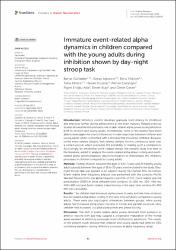| dc.contributor.author | Güntekin, Bahar | |
| dc.contributor.author | Alptekin, Simay | |
| dc.contributor.author | Yıldırım, Ebru | |
| dc.contributor.author | Aktürk, Tuba | |
| dc.contributor.author | Uzunlar, Hakan | |
| dc.contributor.author | Çalışoğlu, Pervin | |
| dc.contributor.author | Eroğlu Ada, Figen | |
| dc.contributor.author | Atay, Enver | |
| dc.contributor.author | Ceran, Ömer | |
| dc.date.accessioned | 2023-10-23T11:54:45Z | |
| dc.date.available | 2023-10-23T11:54:45Z | |
| dc.date.issued | 2023 | en_US |
| dc.identifier.citation | Güntekin, B., Alptekin, S., Yıldırım, E., Aktürk, T., Uzunlar, H., Çalışoğlu, P. ... Ceran, Ö. (2023). Immature event-related alpha dynamics in children compared with the young adults during inhibition shown by day-night stroop task. Frontiers in Human Neuroscience, 17. https://doi.org/10.3389/fnhum.2023.1218559 | en_US |
| dc.identifier.issn | 1662-5161 | |
| dc.identifier.uri | https://doi.org/10.3389/fnhum.2023.1218559 | |
| dc.identifier.uri | https://hdl.handle.net/20.500.12511/11626 | |
| dc.description.abstract | Introduction: Inhibitory control develops gradually from infancy to childhood and improves further during adolescence as the brain matures. Related previous studies showed the indispensable role of task-related alpha power during inhibition both in children and young adults. Nonetheless, none of the studies have been able to investigate the direct differences in brain responses between children and young adults when confronted with a stimulus that should be inhibited. Because, unlike event-related designs, task-related designs involve continuous tasks over a certain period, which precludes the possibility of making such a comparison. Accordingly, by employing event-related design, the present study first time in the literature, aimed to analyze the event-related alpha phase locking and event-related alpha synchronization/ desynchronization to differentiate the inhibitory processes in children compared to young adults. Methods: Twenty children between the ages of 6 to 7 years and 20 healthy young adult subjects between the ages of 18 to 30 years were included in the study. Day-night Stroop task was applied to all subjects during 18-channel EEG recordings. Event-related time-frequency analysis was performed with the complex Morlet Wavelet Transform for the alpha frequency band (8–13 Hz). Event related spectral perturbation (ERSP) in three different time windows (0–200 ms, 200–400 ms, 400–600 ms) and Event-related phase locking in the early time window (0–400 ms) was calculated. Results: The children had increased alpha power in early and late time windows but decreased alpha phase locking in the early time windows compared to young adults. There were also topological differences between groups; while young adults had increased alpha phase-locking in frontal and parietal electrode sites, children had increased occipital alpha power and phase locking. Discussion: The shift in event-related alpha power observed from posterior to anterior regions with age may suggest a progressive maturation of the frontal areas involved in inhibitory processes from childhood to adulthood. The results of the present study showed that children and young adults had different EEG oscillatory dynamics during inhibitory processes at alpha frequency range. | en_US |
| dc.language.iso | eng | en_US |
| dc.publisher | Frontiers Media SA | en_US |
| dc.rights | info:eu-repo/semantics/openAccess | en_US |
| dc.rights | Attribution 4.0 International | * |
| dc.rights.uri | https://creativecommons.org/licenses/by/4.0/ | * |
| dc.subject | EEG | en_US |
| dc.subject | Brain Oscillations | en_US |
| dc.subject | Event-Related Alpha Oscillations | en_US |
| dc.subject | Inhibition | en_US |
| dc.subject | Maturation | en_US |
| dc.title | Immature event-related alpha dynamics in children compared with the young adults during inhibition shown by day-night stroop task | en_US |
| dc.type | article | en_US |
| dc.relation.ispartof | Frontiers in Human Neuroscience | en_US |
| dc.department | İstanbul Medipol Üniversitesi, Tıp Fakültesi, Temel Tıp Bilimleri Bölümü, Biyofizik Ana Bilim Dalı | en_US |
| dc.department | İstanbul Medipol Üniversitesi, Rektörlük, Sağlık Bilim ve Teknolojileri Araştırma Enstitüsü | en_US |
| dc.department | İstanbul Medipol Üniversitesi, Sağlık Bilimleri Enstitüsü, Sinirbilim Ana Bilim Dalı | en_US |
| dc.department | İstanbul Medipol Üniversitesi, İMÜ Meslek Yüksekokulu, Elektronörofizyoloji Ana Bilim Dalı | en_US |
| dc.department | İstanbul Medipol Üniversitesi, İnsan ve Toplum Bilimleri Fakültesi, Psikoloji Bölümü | en_US |
| dc.department | İstanbul Medipol Üniversitesi, Tıp Fakültesi, Dahili Tıp Bilimleri Bölümü, Çocuk Sağlığı ve Hastalıkları Ana Bilim Dalı | en_US |
| dc.authorid | 0000-0002-0860-0524 | en_US |
| dc.authorid | 0000-0002-7715-3035 | en_US |
| dc.authorid | 0000-0002-7555-3801 | en_US |
| dc.authorid | 0000-0003-3499-2370 | en_US |
| dc.authorid | 0000-0002-4331-1656 | en_US |
| dc.authorid | 0000-0002-8968-4079 | en_US |
| dc.identifier.volume | 17 | en_US |
| dc.relation.publicationcategory | Makale - Uluslararası Hakemli Dergi - Kurum Öğretim Elemanı | en_US |
| dc.identifier.doi | 10.3389/fnhum.2023.1218559 | en_US |
| dc.institutionauthor | Güntekin, Bahar | |
| dc.institutionauthor | Alptekin, Simay | |
| dc.institutionauthor | Yıldırım, Ebru | |
| dc.institutionauthor | Aktürk, Tuba | |
| dc.institutionauthor | Uzunlar, Hakan | |
| dc.institutionauthor | Çalışoğlu, Pervin | |
| dc.institutionauthor | Eroğlu Ada, Figen | |
| dc.institutionauthor | Atay, Enver | |
| dc.institutionauthor | Ceran, Ömer | |
| dc.identifier.wosquality | Q2 | en_US |
| dc.identifier.wos | 001080320600001 | en_US |
| dc.identifier.scopus | 2-s2.0-85173787131 | en_US |
| dc.identifier.pmid | 37822709 | en_US |
| dc.identifier.scopusquality | Q2 | en_US |



















